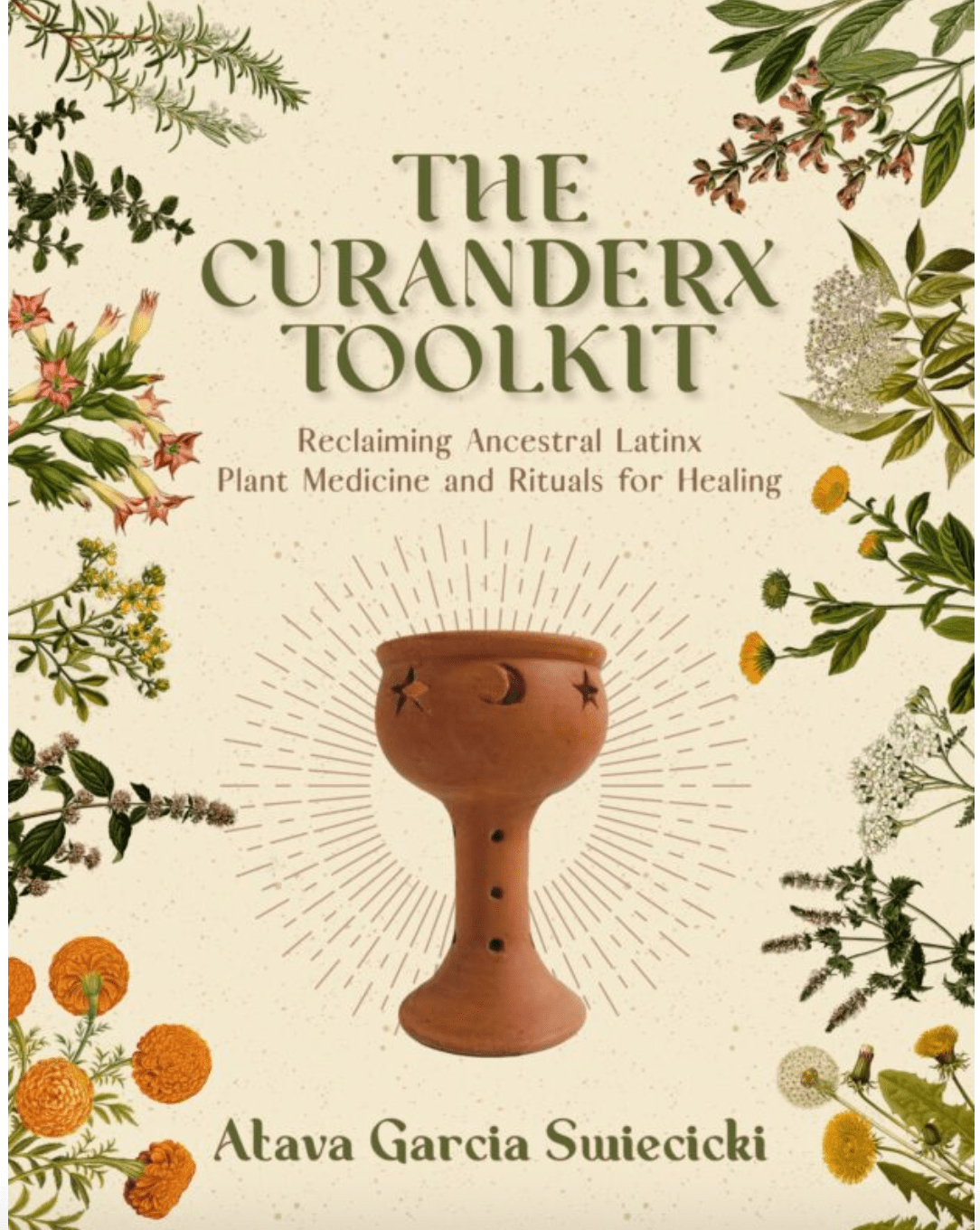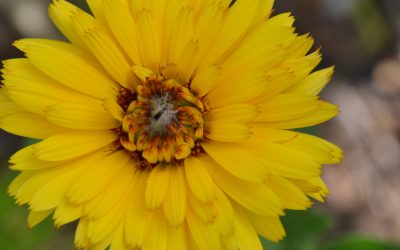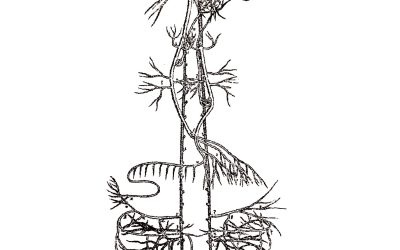Caring for Our Broken Hearts
Herbal Remedies and Practices for Heartbreak and Grief
Loss and grief are an inevitable part of being human, and we all will experience both in our lifetimes. Modern westernized culture doesn’t offer many tools to support us when we are facing loss, whether it by death of a loved one, a pet, loss of a job, a relationship, or loss of one’s health. After a major loss, like a death of a family member, at most we are given a few weeks of bereavement time and then expected to be ready to go back to work and back to “normal”. Grief can be overwhelming, exhausting and the process to recover from a major loss can take a long time.
Each of us has our own personal experience of loss and grief. Moreover, we are living through times when we are also experiencing high levels of collective grief. We are bombarded each day with terrible news of injustice, violence, mass shootings, war, genocide, ecocide, fires, droughts, floods, and an unprecedented threat to life on earth due to climate chaos. Our ambient levels of collective stress are high and many of us may feel ill equipped to handle the entourage of emotions, not only grief, but also anger, despair, powerlessness and hopelessness.
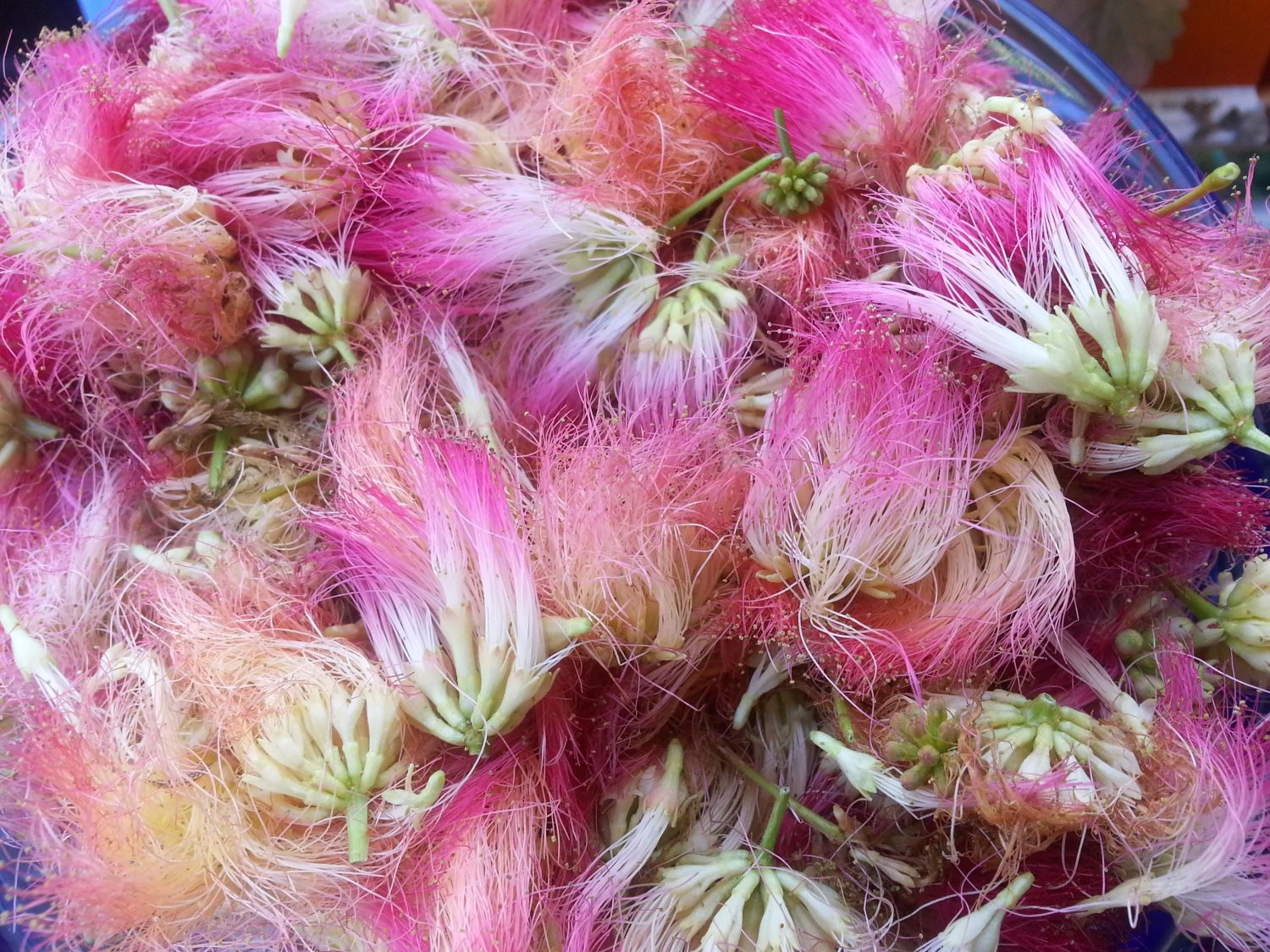
Mimosa, Albizia spp. (see Herbal Allies below)
I believe that plant medicine and ancestral medicine practices like curandersimo have a lot to offer us in these turbulent times. Herbs can be great allies to support us while we navigate the grieving process. Practices of curanderismo, like limpias and baños, help us to create space to recognize, honor and release not only grief, but all our emotions, which in curanderismo we call aires (airs or winds). When we feel overwhelmed and overburdened with heavy emotions, we can support ourselves by making a nourishing cup of tea, by performing a self-limpia or by creating a healing bath/baño. When our need is greater than what we can manage by ourselves, we can seek support of a loved one, an herbalist, healer, therapist or curanderx. Our plant allies help us tend to our bodies, hearts, minds and spirits. Whether we are making ourselves an herbal tea to calm our nerves, or we are drawing a bath of fresh flowers and herbs to tend to a broken heart, with each of these practices we can make a sacred container to honor our process of grieving.
Herbal allies and supportive practices of curanderismo can support us during the process of grief; but I want to be clear that they cannot take away grief and they are not a substitute for the arduous process of grieving. Grief is a normal and natural part of life which has its own cycle and timespan, and grief is a process we must experience thoroughly before it will resolve. Our herbal allies are like friends who love us unconditionally and offer us comfort and nourishment while we do the hard work of grieving. Practices of curanderimso can help us to honor the sacredness of our grief and help us to keep our emotional energies moving and offer opportunities to let go and release when we are ready to do so.
Join Atava’s Live Online Class: Tending to Grief with Herbal Allies March 9, 2024
Connection with Nature
To connect with the healing power of plants to support our grieving process, we don’t even need to ingest them as a tea or tincture. The natural world is intrinsically healing, and by taking time outside in nature we can soak in the medicina of the sun, sky, trees, plants, birds, animals, mountains, rivers, oceans, or whatever natural beauty is available to us. Although the understanding of the healing power of the natural world has been long understood by indigenous and traditional people, modern science is now beginning to study and acknowledge the benefits. In a 2019 British study of 20,000 people, researchers discovered that people who spent two hours per week in nature reported much higher levels of good health and overall feelings of wellbeing.[i] Regular time in nature has been discovered to have multiple benefits for both our physical and mental health. The time we enjoy in our gardens, on a hike, or sitting quietly in a neighborhood park can alleviate stress, improve mood, increase cognitive functioning, lower blood pressure, and increase immune functioning.[ii]
Sunrise Meditation
I recommend regular time in nature to anyone who is grieving. When you go outside any time of day, it can be beneficial and healing. In curanderismo, we learn to observe the healing effects of different times of the day and night. As the sun, moon and stars glide through the sky, they offer different kinds of medicina to us here on Mother Earth Tonanatzin. The medicina of sunrise can be extra supportive to grief. Sunrise is a time when darkness of the night dissipates, and the light of the sun brings a new day. It offers us the daily experience of new beginnings, when we are offered a fresh start. The quiet, contemplative medicina of sunrise can offer peace, calm, and a renewed sense of hope.
When my clients are experiencing loss and grief, I normally recommend that they wake up early and witness the sunrise for a few days in a row. Simply being outside for the sunrise is beneficial, but it can also be a good time to practice meditation or to pray. Gaze at the sunrise and allow yourself to soak in the medicina of the rose-colored light, the stillness, the bird song, and the sensation of life awakening to greet the sun and the new day. Allow the gentle morning light to bless your entire being and wash away the weight of grief, sadness and despair.
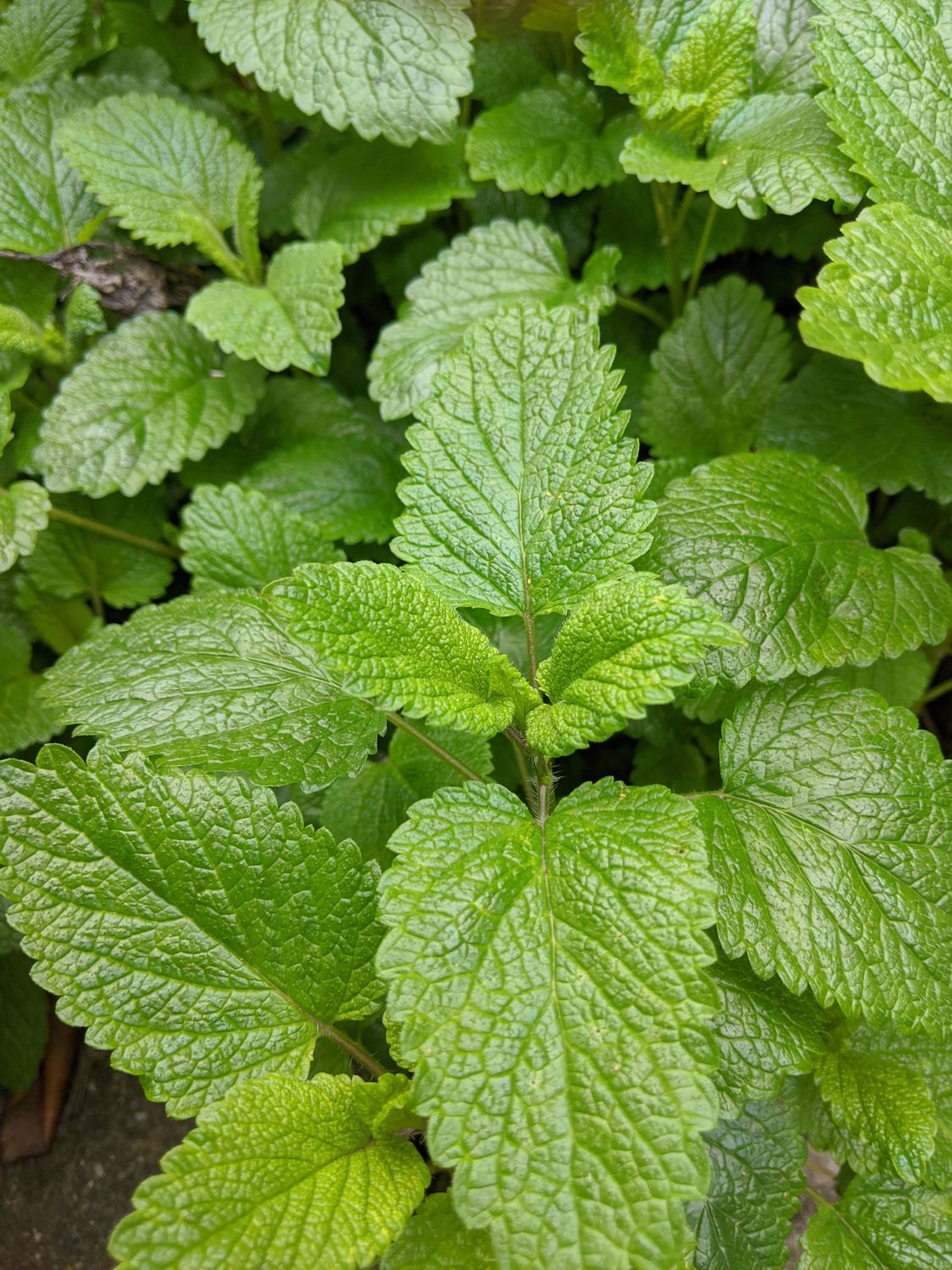
Lemon Balm, Melissa officinalis (see Herbal Allies below)
Herbal Allies
There are endless herbs that can offer support while we grieve. Here are a few of my favorites:
- Mimosa, Albizia julibrissin (used in Traditional Chinese Medicine), Albizia dysocarpa & Albizia biuncifera (both native to the US Southwest)
One of the names of mimosa is “the happiness plant.” Some people refer to it as ‘the herbal Prozac,” but as an herbalist who knows that plants were humanity’s first medicine, I prefer to call Prozac “the pharmaceutical Mimosa.” Mimosa has been used as an herbal remedy in Traditional Chinese Medicine to relieve depression, sadness and to uplift the spirits. Mimosa flowers are fuzzy and bright pink and remind me of the Lorax characters from a Dr. Seuss book. Just looking at mimosa flowers can bring a smile to my face. Both the flowers and bark can be used as a tea or tincture for their mood lifting qualities. Certain species of mimosa (dyscocarpa and biuncifera) grow in parts of the Southwest and mimosa trees are a common landscape plant here in Albuquerque.
- Lemon Balm, Melissa officinalis
Lemon balm is a lovely member of the mint family. It grows easily in New Mexico gardens and can be easily identified by its sweet, lemony scent. Lemon balm is an herbal nervine, which means it nourishes and supports the nervous system. It is harmonizing to the emotions and can both calm anxiety and can also alleviate depression. Its lemony scent can be both soothing and uplifting. I like to rub my fingers on its leaves and inhale its scent. I work with lemon balm with myself and my clients to offer emotional support in times of trauma, stress, grief and loss. Lemon balm brings sweetness and my first herbal teacher, Karyn Sanders, taught me that lemon balm has a particular affinity for healing sexual trauma. I use it to support people after miscarriage, abortion, hysterectomy, sexual assault or any kind of sexual or reproductive trauma.
- Scullcap, Scutellaria officinalis
Scullcap was one of my first herbal allies. I discovered it as a young woman when I was struggling with sleep issues, and it not only helped me to sleep but it also turned me on to the incredible world of medicinal plants. Scullcap is also a member of the mint family. Unlike most mints, it doesn’t have a distinctive scent, but can be identified by its bright blue flowers. Scullcap is one of the plants I dug up from my Oakland garden and transplanted here to my high desert garden. I am happy to report that it is thriving in its new habitat and seems happier than it did living in a coastal Mediterranean climate.
Like lemon balm, skullcap is also an herbal nervine. Scullcap is useful for stress, nervous exhaustion, burn out, agitation, nervous tics and tremors, and insomnia. The grieving process can also leave us feeling exhausted and skullcap is one of the first herbs I think about to support our depleted nervous systems. For this I often combine it with another nervine, wild oat (avena sativa). Scullcap also can help us when grief disrupts our sleep and can be calming in small doses and sedating in larger doses. I like to use it as a tea or tincture.
- Tulsi/Holy Basil, Ocimum sanctum
Tulsi has been cultivated and used in India and Southeast Asia for centuries, where it is considered to be a very sacred herb. In Ayurveda it is known as a rasayana, an exceptional herb that promotes health and longevity. As a relative of culinary basil, Tulsi thrives in hot weather and with the proper amount of water it grows well in our high desert climate.
Tulsi has a bright, pungent scent similar to basil and is warming, energizing and uplifting. As an adaptogen, Tulsi helps us to be resilient in the face of stress, which includes the stress of facing loss and grief. Adaptogens work by supporting our nervous, immune, and endocrine systems to adapt to all kinds of stressors, including environmental, emotional, and physical stressors. Tulsi can bring warmth to our heavy hearts and help alleviate depression and sadness. Tulsi can help soothe the sharp edges of grief. In my experience, Tulsi feels like a warm embrace from the Divine Earth Mother. It also is a great herb for the mind and can help to relieve brain fog that often accompanies the process of grief. My favorite way to ingest Tulsi is in tea. It is energizing but not stimulating like caffeine and I often drink it in the afternoon to give me a boost of energy.
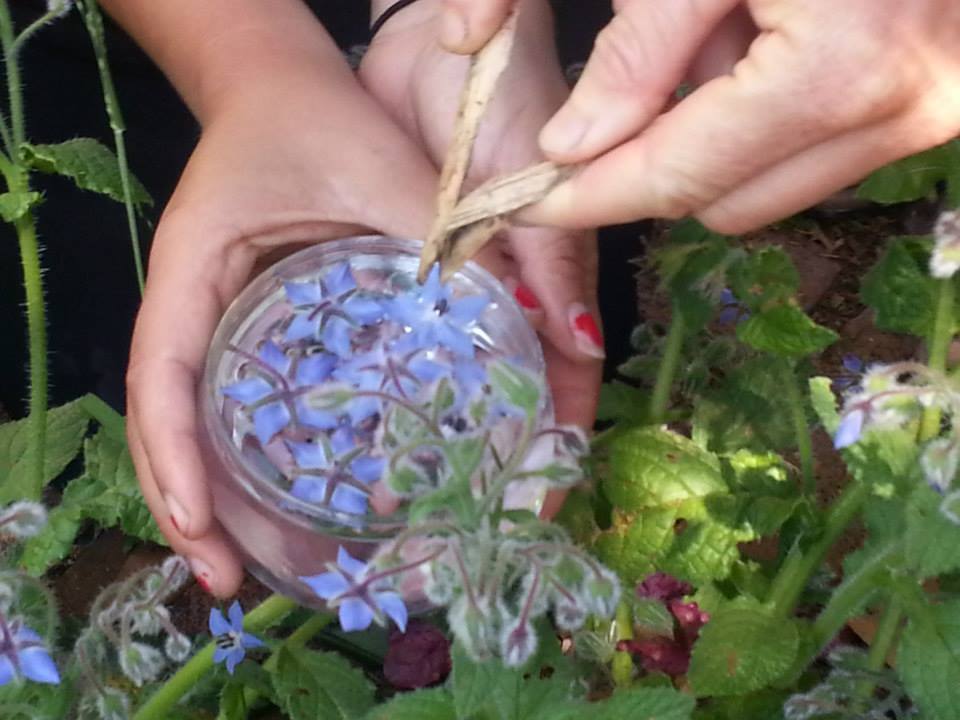
Borage (see Flower Essence Support below)
Flower Essence Support
Flower essences are energetic remedies made from the fresh blossoms of a plant. Flower essences were first popularized by British physician and homeopath Edward Bach in the 1930’s. He developed a line of flower essences made from flowers he found growing in the English countryside. Decades after Bach’s death, people all around world rediscovered his work and began making flower essences from flowers in their local environment. I love flower essences because they are easy to make, are safe, non-toxic, and offer gentle yet powerful healing. Called “nature’s tuning forks” by flower essence practitioner Cynthia Athina Kemp Scherer, flower essences help to harmonize our energetic bodies, by attuning us to the beautiful, high vibrations of nature. They do not work on a physiological level like herbal medicine, but instead work on the energetic level of our thoughts, emotions, and patterns and behaviors. The typical dose for a flower essence remedy is four drops, taken four times a day. To increase the effect, we can take them more frequently than four times daily, but we never need to take more than four drops. Flower essences can be taken internally, or we can also apply them topically to the body. For heartbreak I like to apply flower essences directly to the heart area.
Learn to Make Flower Essences in Atava’s Book: The Curanderx Toolkit
- Bleeding Heart Flower Essence
Bleeding heart is a remarkable plant, with pink heart shaped flowers. Bleeding heart flower essences is one of my top remedies for heartbreak and grief. It is indicated when our grief feels raw and painful. Bleeding heart flower essence feels like a balm for the emotional heart and it soothes the jagged edges of heartbreak.
It is important to note that bleeding heart as a plant is toxic. Remember that a flower essence is a very diluted solution of the plant, which has almost none of the physical constituents of the actual plant. Bleeding Heart is used as an herbal remedy only by experienced practitioners who know how to work with it in small doses. Never ingest bleeding heart herb unless under the guidance of an experienced herbalist.
- Borage Flower Essence
Borage has long been used as a culinary and medicinal herb. It has fuzzy, almost prickly leaves and baby blue star shaped flowers. As a flower essence remedy it helps to lift our spirits when we feel heavy hearted. It brings fresh perspective and a renewed sense of levity and playfulness. It also helps to strengthen a heart that is weary with grief.
- Cempasuchil/Aztec Marigold Flower Essence
Cempasuchil or Aztec Marigold is a well-known as the primary flower used in ofrendas (offerings) on our Dia de los Muertos altars. It has bright, puffy orange flowers that stay remarkably fresh without water, even days after they’ve been cut. Cempasuchil has a long tradition in Mexico as a ceremonial and medicinal plant. During Dia de los Muertos, its presence on our altars helps to comfort us while we grieve our loved ones who have passed. I use it similarly as a flower essence and include it in my client’s remedies when they are grieving the loss of a loved one or facing some other significant loss.
- Wild Rose Flower Essence
Throughout the world, roses are associated with love and matters of the heart. As a flower essence, Wild Rose is indicated when grief (or other life experiences) leaves our hearts feeling numb and listless. A person needing Wild Rose essence may feel apathetic and like they have lost their zest for life. Wild Rose helps to reenergize the emotional heart and bring a renewed sense of vitality and engagement with life.

Rose, Rosa spp. (see Flower Essence Support above)
Baños/Herbal Baths
One of my favorite ways of engaging with plants when dealing with grief or any other heavy emotion is to create a baño or herbal bath for myself. In curanderismo, baños are a traditional way of working with plants and we administer baños through all phases of life, from birth to death and all stages in between. Baños bestow us with the blessing of herbs and flowers along with the healing energy of water.
How does a baño differ from an ordinary bath? I think it is the intention and ritual we bring to our baño. We intentionally create a sacred space not just to bathe our physical body, but to tend to the deep needs of our soul. We invite in the energiás of the plantitas, to support our healing. We talk or sing to the plants as we harvest them and prepare them for our baño. We let the plants know our healing intention for ourselves. We pray to the water and ask it to help relieve our pain and suffering.
Many herbs and flowers can be part of your baño. I like to use fresh, aromatic plants such as rosemary, lavender, sage or roses when I have them available. We can also use dried herbs if fresh ones aren’t accessible. Fresh flowers are a nice addition to a baño but I like to make sure they aren’t sprayed with pesticides (as most are that are sold in stores). What we put into our bath water is absorbed into our skin, so we don’t want to expose ourselves to toxic chemicals in our bath.
There are a few different ways to prepare your herbal baño. One is to find a large soup pot, fill it with water and bring the water to a boil. Once the water has reached a boil, turn off the heat, add your herbs with your prayers and intentions and cover and steep. I recommend that you steep your herbs for at least 30 minutes or longer. Next you can add the hot herbal water directly to the bath. You can choose to strain the herbs or bathe with the plant material. I like to soak with my plantitas, although that always makes clean up more difficult.
Another option, if you don’t have a bathtub, is to take the pot of hot herbal water (after it has steeped) into your shower. You’ll need a ladle, a gourd or cup to use to pour the baño water over your body. Dip the cup into the baño water and lovingly wash and bless yourself with the water. Talk to the water and ask for its healing and blessing.
After your baño I have been taught to immediately lie down and wrap myself up in blankets. It is important to stay warm and not let yourself be exposed to a draft. Swaddle yourself like a newborn. Rest and allow the healing to continue.
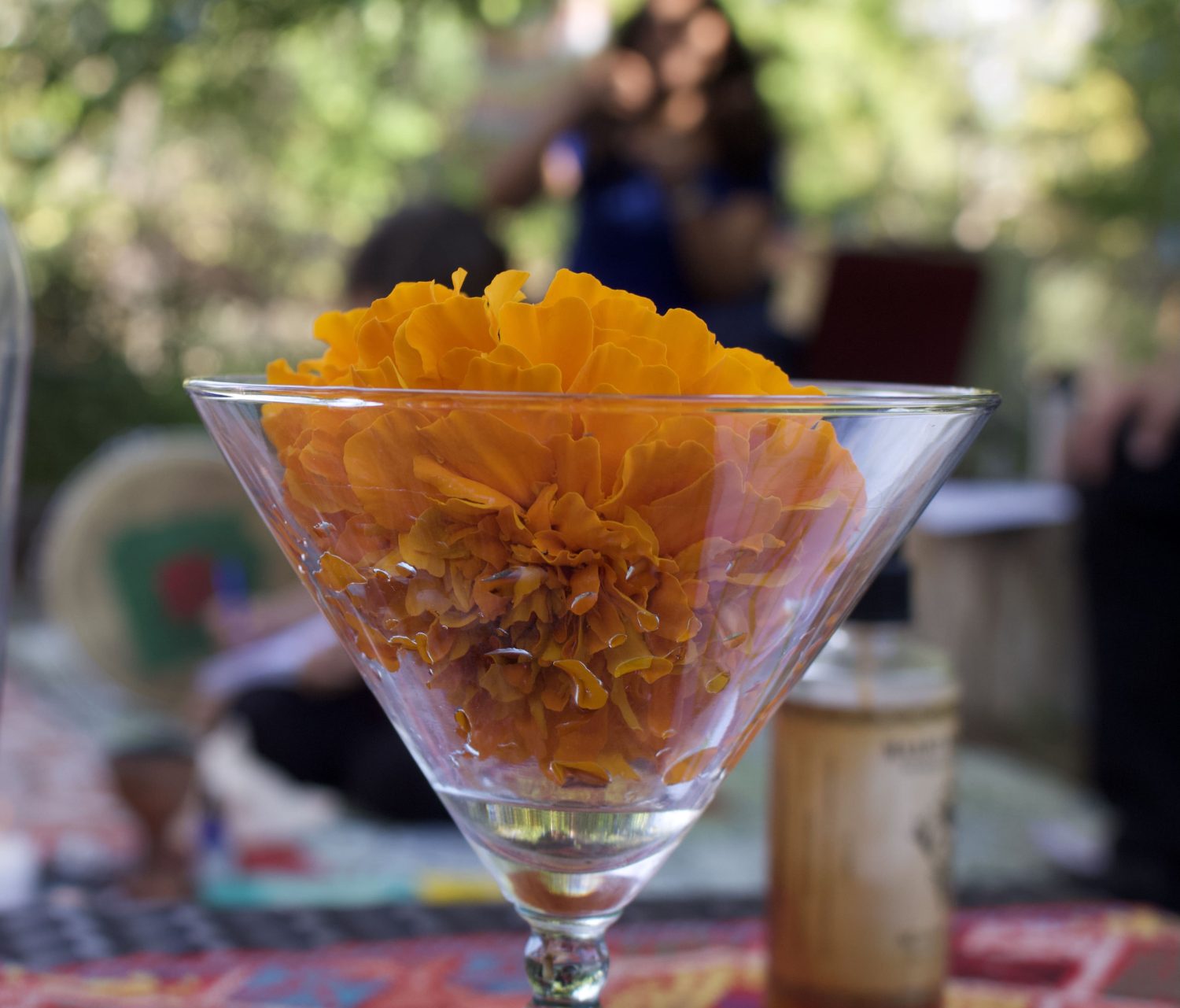
Aztec Marigold Flower Essence
Baño Recipes:
Heart Healing Baño:
(Herbs can be used fresh or dry)
- 1 part rose petals
- 1 part lavender
- 13 drops bleeding heart flower essence
- 13 drops borage flower essence
Grief Release Baño
- 1 part rosemary
- 1 part cempasuchil
- 1 part rose petals
There is no exact recipe for a baño. Let your intuition guide you to the plants you need and work with what is growing around you or stored in your herbal cabinet. Take time to journal before and after your baño and note the healing effects in your body, mind and spirit. For significant loss and grief, we sometimes need a series of baños to support the healing. In this case, I will often recommend that my clients do a baño four days in a row, or once a week for four weeks.
May you discover your herbal allies to support you not only during times of grief and loss, but wherever you are stressed or dealing with difficult emotions. By incorporating these plants and practices into our lives, it can make a huge difference in how we experience emotional healing and wellbeing.
Read More in Atava’s Book: The Curanderx Toolkit
Arranging ofrendas. Brewing pericón into a healing tea. Releasing traumas through baños and limpias. Herbalist and curandera Atava Garcia Swiecicki spent decades gathering this traditional knowledge of curanderismo, Mexican folk healing, which had been marginalized as Chicanx and Latinx Americans assimilated to US culture. She teaches how to follow the path of the curandera, as she herself learned from apprenticing with Mexican curanderas, studying herbal texts, and listening to her ancestors. In this book readers will learn the Indigenous, African, and European roots of curanderismo. Atava also shares her personal journey as a healer and those of thirteen other inspirational curanderas serving their communities. She offers readers the tools to begin their own healing—for themselves, for their relationship with the earth, and for the people.
Endnotes
[i] White, M.P., Alcock, I., Grellier, J. et al. Spending at least 120 minutes a week in nature is associated with good health and wellbeing. Sci Rep 9, 7730 (2019). https://doi.org/10.1038/s41598-019-44097-3, https://www.nature.com/articles/s41598-019-44097-3
[ii] Robbins, John. Ecopsychology: How Immersion in Nature Benefits Your Health. Yale 360, January 20, 2020. https://e360.yale.edu/features/ecopsychology-how-immersion-in-nature-benefits-your-health

